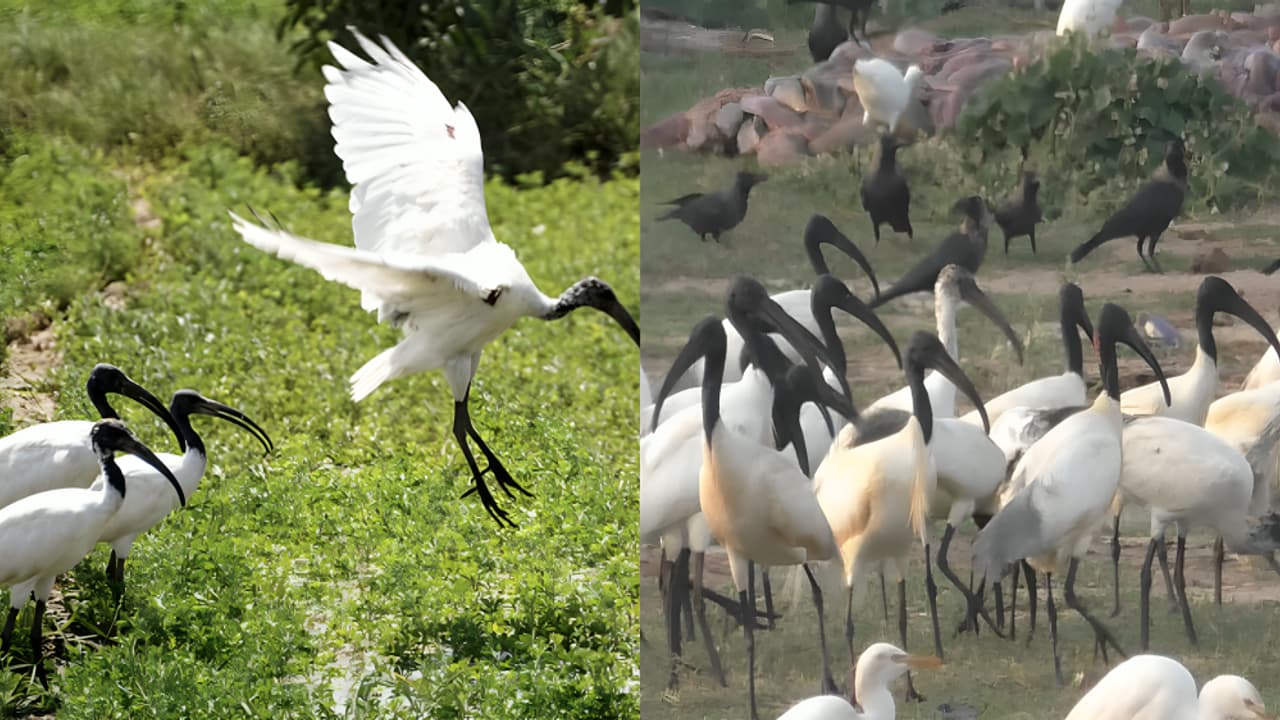Rare sighting of Black-Headed Ibis in Thoothukudi salt pans is a positive sign of ecological recovery. Experts say the bird’s presence shows that the salt pan habitat still supports rich wetland life. It reflects improving environmental conditions.
A flock of the rare bird black‑headed Ibis was seen in the salt pan regions of Thoothukudi district in Tamil Nadu. This wading bird has a white body, a black head and a long curved beak. Found mostly in wetlands, it is classed near-threatened and its presence in salt pans suggests improving ecology in the area.
What is the Black-headed Ibis?
- The Black-headed Ibis (scientific name: Threskiornis melanocephalus) is a large waterbird found in South and Southeast Asia. Here are its key features:
- It has an all-white body, but a black head and neck, and a long, curved black beak.
- Adults measure about 65-76 cm in length.
- The species uses wetlands, marshes, rivers, rice-fields and even man-made shallow water bodies for feeding and nesting.
- It is listed as Near Threatened in some assessments because its habitats are threatened.
What is the significance of the sighting in Thoothukudi
A sighting of the Black-headed Ibis in the salt pans of Thoothukudi district in Tamil Nadu is notable for several reasons:
- Salt pans are coastal and often industrial or semi-wild landscapes. The fact that this species is present suggests that wildlife is using these areas.
- The region can support this kind of bird only if shallow water, feeding grounds and relatively safe habitat exist, which indicates some positive ecological conditions.
For bird watchers and conservationists, hearing about a flock of a rarer species is always a good sign and prompts further attention to habitat protection.
Habitat, diet and behaviour Habitat
The Black-headed Ibis thrives in shallow wetlands: marshes, flooded grasslands, rice fields, mud-flats, salt-marshes and lagoons. It is adaptable and uses both natural and man-made shallow water sites.
It uses its long, curved bill to probe in mud and shallow water for prey. It eats insects, worms, crustaceans, small fish, frogs and other small aquatic creatures. It often forages alone or in small groups, but may roost in larger flocks.
During breeding season its tail feathers change colour and bare patches under the wing may turn red-tinged.
Threats and conservation
This species faces several threats:
- Loss of wetland habitat due to drainage, land conversion and pollution.
- Disturbance of feeding and nesting sites.
Changes in water-levels or salinity may reduce food availability. Conservation efforts include monitoring wetland health, protecting nesting sites, and ensuring that shallow waters remain available and safe for foraging.
How the sighting of Black‑headed Ibis is GOOD news and what it means for the local ecosystem
The appearance of these ibises in the salt-pan region means:
Good sign for habitat health: If a species that needs wetland-type conditions can survive there, it suggests that the ecosystem is not entirely degraded.
Potential for more bird diversity: The salt-pan area may attract other wetland-dependent and migratory birds if conditions remain favourable.
Opportunity for eco-tourism and awareness: Bird enthusiasts visiting such areas help raise awareness and support for conservation of these habitats.
If you go bird-watching in Thoothukudi’s salt pans or similar habitats, here’s what to check:
- Look for white birds with black heads and down-curved black bills – that’s the Black-headed Ibis.
- Pay attention to shallow water areas, mud-flats and fringes of salt pans early morning or late afternoon when birds feed.
- Respect the habitat: avoid disturbing roosting or feeding birds, keep distance and minimise noise.
- Join or support local nature-enthusiast groups: they often spot interesting migratory or resident birds.
The rare sighting of the Black-headed Ibis in Thoothukudi is a gentle but meaningful reminder that even in places that seem industrial or marginal like salt pans, nature persists when given space and care. With attention, protection and respect, we can hope those white-bodied birds with black heads continue to grace our wetlands, enriching our little piece of the world and reminding us of the value of wild places.
(With ANI inputs)
